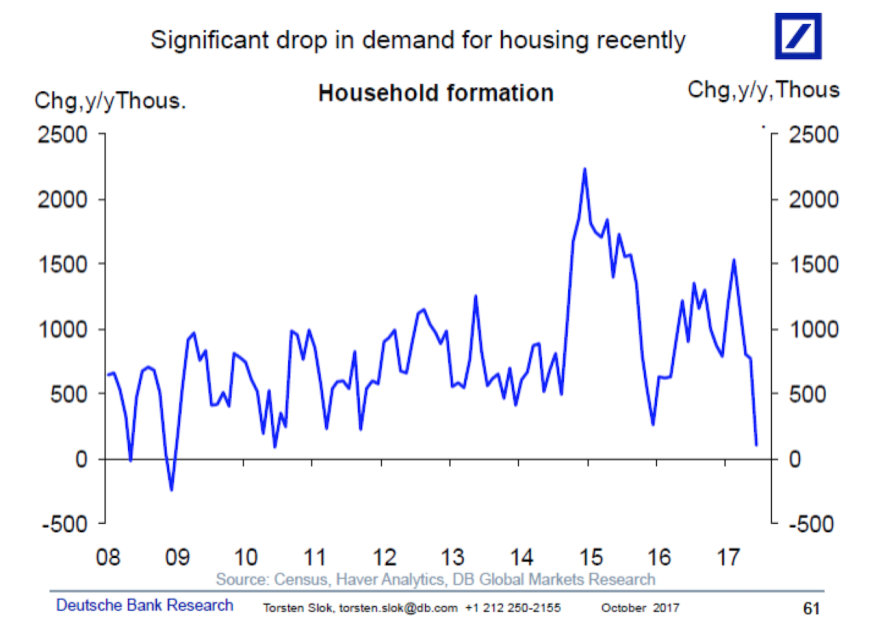Torsten Slok, Ph.D., is chief international economist and a managing director at Deutsche Bank Securities. The question Slok asked yesterday morning was this.
Is household formation dropping because of affordability?
Here’s his chart.

It shows household formations falling off the table in 2017. Dr. Slok looks at the data and sees a big red flag.
In the initial years after the crisis household formation was around 600k to 700k, see chart below. Then household formation jumped to +1mn as young people completed their education and started moving out of their parents’ basement. But recently we have seen a significant drop in the number of new households, and we are worried that the slowdown in housing demand is driven by very high home prices and housing simply becoming unaffordable for new families.
The dots Slok inferrentially connects bridge this observation about national economics’ basic building block–the household–and the performance of the broader economy itself.
To be sure, the housing market remains a small share of the overall economy, but it is important because it is one of the most cyclical components of GDP.
For a clue into this unsettling flash point, one might look deep into the insights brought to light last week in an analysis from New York University’s Furman Center. On the surface, the headline take-away is encouraging, noting as it does that the percentage of United States households who are rent-burdened–spending 30% or more of their wages on monthly housing costs–fell by a percentage point between 2012 and 2015.
The report explores a relatively new phenomenon–more wealthy and higher-educated people are choosing to rent–that partly accounts for this statistical shift to fewer rent-burdened households.

The income of the typical renter household increased along with overall incomes in the economic recovery period, but more of the renter households were highly educated, had higher incomes, and were employed. Therefore, not all of the measured increase in renter income was due to renters making more income per se; rather, part of it was due to a shift in who was choosing to rent.
It’s here that we might discover insight into how the two trends–a slower household formation growth due to less affordability in many places, and the slight improvement in the share of rent-burdened households.
It’s evidence vested and invested players in residential real estate development and construction are working in not one, but two, related but disconnected housing businesses.
In one part of the housing business, players are growing around their competence at asking people with means how it is they want to live in their homes and communities, and profitably developing, designing, engineering, building, and marketing neighborhoods that answer to those preferences profitably.
read more…
http://www.builderonline.com/money/affordability/a-tale-of-two-housing-economies_o?utm_source=newsletter&utm_content=Article&utm_medium=email&utm_campaign=BP_101217%20(1)&he=bd1fdc24fd8e2adb3989dffba484790dcdb46483
